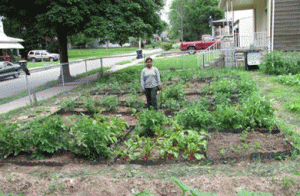Gardening on vacant lots in urban and suburban areas is becoming more and more popular. There are many benefits to this, provided some basic precautions are taken, says Ganga Hettiarachchi, Associate Professor of Agronomy, Soil and Environmental Chemistry.
“Anyone who raises food on these soils should have the soil tested for potentially harmful contaminants,” Hettiarachchi says.
Her research team in Agronomy has been working for the past several years to find out how contaminated soils could be made safe for gardening, and how garden crops grown on contaminated soils should be cleaned before they are eaten.

What are the potential contamination problems? Urban soils have sometimes been found to contain toxic levels of heavy metals including lead, arsenic, cadmium, mercury, zinc, nickel, and copper. Contamination may have come from paint, gas or oil, waste incineration, lead pipes, specific industries, and so forth. Lead is one of the most common contaminants.
A new K-State Research and Extension publication, Gardening on Lead-Contaminated Soils, has been published to help gardeners with this issue. It was written by Hettiarachchi, along with Phillip Defoe, former graduate student in Agronomy, and DeAnn Presley, Associate Professor and Extension Soil Management Specialist. The publication is now available online at: http://www.ksre.ksu.edu/bookstore/pubs/MF3166.pdf
This publication was based in part on research done by Hettiarachchi and her graduate students, such as Chammi Attanayake, on a garden plot in the Washington Wheatley area of Kansas City.
“We studied two general approaches to minimizing lead contamination at this site — soil treatments (to reduce plant uptake) and food preparation methods,” Hettiarachchi said.

Plant uptake and soil amendment treatments
Some garden crops absorb more lead than others. Root crops such as carrots and beets are more prone to lead absorption than leafy vegetables. Most plants, however, do not absorb high amounts of lead into their systems under normal conditions. On highly contaminated soils (lead concentrations greater than 1,000 ppm) and poor soil conditions (low pH and low organic matter), eating the edible portions of leafy vegetables may become a concern.
Organic amendments, such as compost and animal manure, can reduce lead uptake in vegetables grown on soils moderately contaminated with lead – from 100 to 400 ppm lead. If these amendments are used heavily, mixed in at ratios of 30 to 50 percent compost-to-soil, this can dilute the total lead concentration in soils. It can also increase the total biomass of vegetables. If vegetables have more biomass while uptake of lead remains the same, that effectively reduces the concentration of lead in the vegetables. An increase of total biomass of vegetables could be an effective means of reducing potential lead transfer to humans.
If soils have more than 400 ppm lead, it’s best to grow leafy or fruiting vegetables rather than root crops. Fruits, such as tomatoes, have very low lead concentrations under almost any conditions. If soils have less than 400 ppm lead and root crops are grown, it is advisable to wash them thoroughly before peeling.
Vegetable cleaning methods
Hettiarachchi’s team tested the effect three methods of cleaning vegetables on lead concentrations.
1) Laboratory cleaning. Vegetables were rinsed with tap water, then rinsed with deionized water, then with sodium lauryl sulfate solution, and finally rinsed again with deionized water. The objective was to remove all soil particles from produce surfaces.
2) Kitchen cleaning. Vegetables were rinsed only with tap water, to mimic the washing procedure in a home kitchen. This removed all visible soil particles from the produce.
3) Peeling. After kitchen cleaning, a portion of the carrots were peeled.
The various cleaning methods made a significant difference in lead concentrations of Swiss chard and tomatoes but not for carrots. Swiss chard cleaned with the kitchen cleaning method contained 2.6 to 4.6 times greater lead concentrations than that cleaned with the lab cleaning method. Similarly, kitchen-cleaned tomatoes had 3.0 times greater lead concentrations than lab-cleaned tomatoes.
In contrast, cleaning methods did not significantly affect lead concentrations in carrots. This can be explained by the absence of cuticle lipid layer on the roots. Peeling also did not statistically change lead concentrations in carrots.
Summary
Urban and suburban soils should be tested often for nutrient and pH levels. Testing for micronutrients and heavy metals, such as lead, might also be advisable in any circumstance in which contamination may have occurred. One example is soil close to an older house where flakes of lead-based paint may have contaminated the soil.
If the soil test does indicate lead contamination, it might be a good idea to avoid growing root crops such as carrots in the garden. For leafy vegetables, remove the lower or outer leaves since they will be the leaves most likely to be contaminated with soil particles.
Also, if necessary apply lime to keep the soil close to neutral in pH, or possible slightly alkaline. Lead becomes more available for plant absorption under acidic soil conditions.
Be sure to wash vegetables thoroughly with high-quality water and soap. If soil particles are hard to wash off, peel the vegetables or remove the parts contaminated with soil.
Adding leaf compost to the soil may be a good idea as well, as long as the compost does not itself contain high levels of heavy metals. In our study, the addition of compost diluted initial total soil lead concentrations, indicating that the continuous addition of compost would lower total lead concentration in soils significantly.
In addition, compost addition helps maintain good soil nutrient status in soils. Maintaining good soil fertility and thereby increasing biomass production diluted lead concentrations in the vegetables. The highest concentrations of lead in edible portions were found in root/tuber crops, followed by leafy and fruiting vegetables.